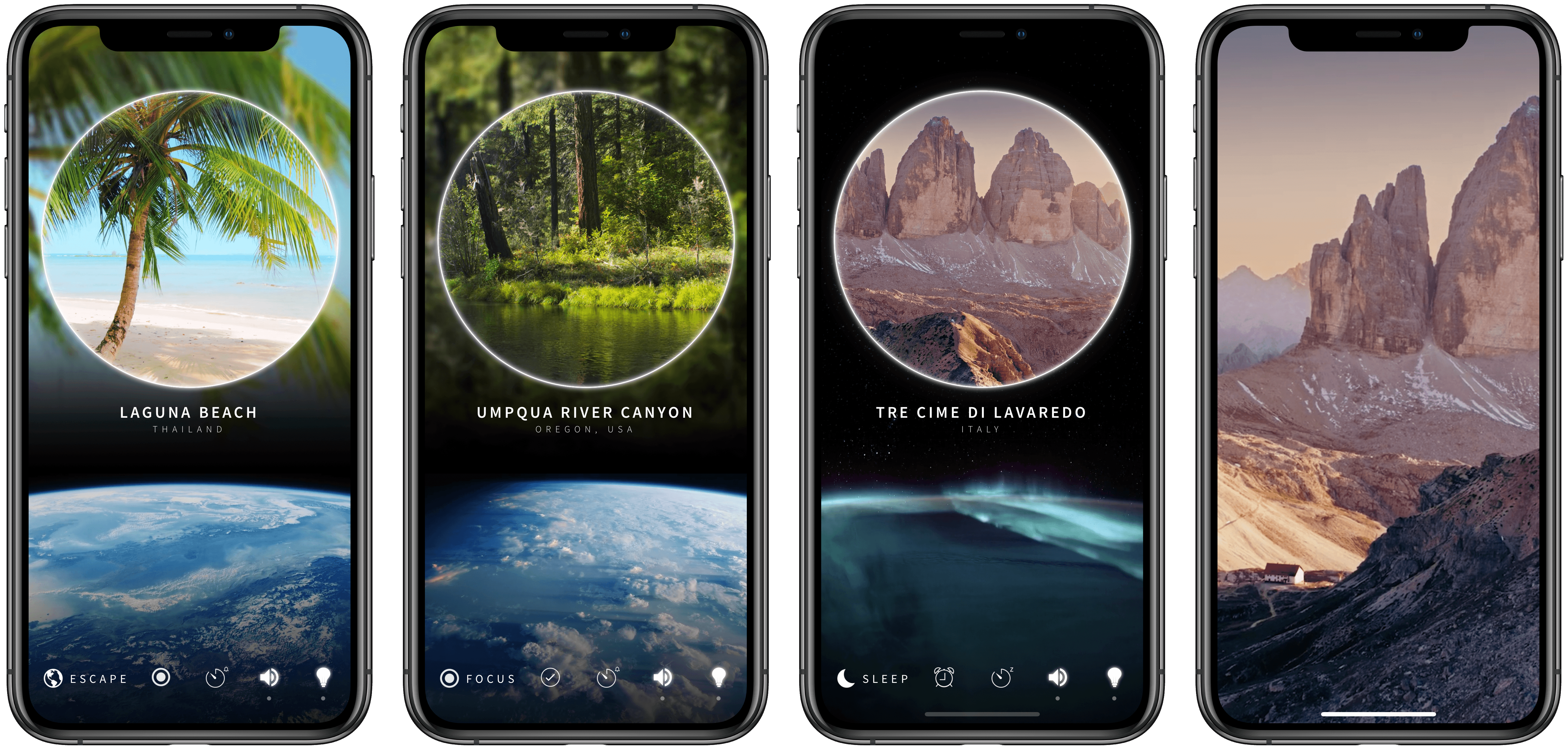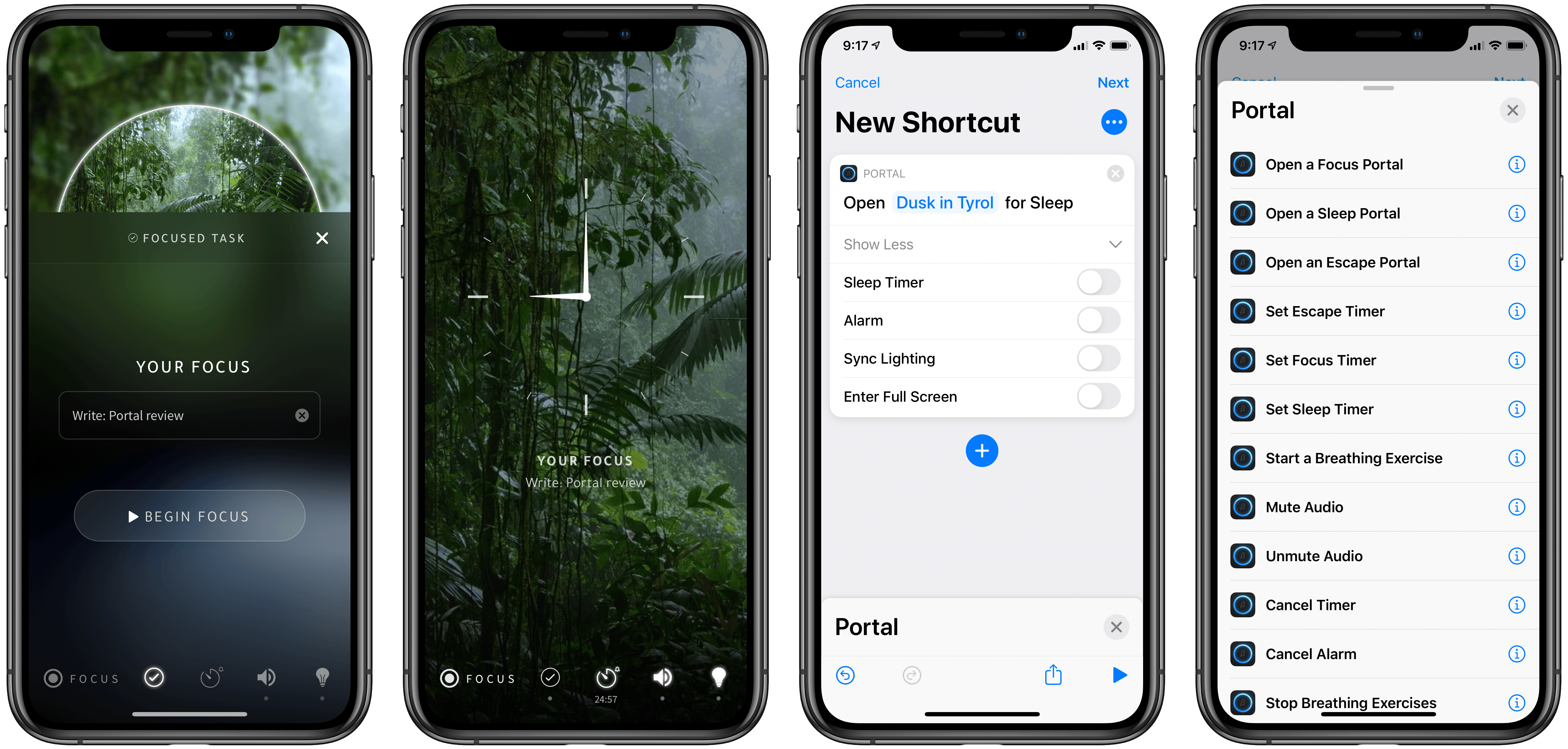Ambient noise apps exist to help you focus or sleep, primarily. They provide a calming effect and complement mode-switching, whether that’s switching to a specific work project, switching from awake to asleep, or some other purpose. Portal, the ambient noise app that bears no relation to Facebook, works well for these purposes – in fact, focus and sleep are two of the three pillars Portal highlights in its name. However, the third pillar – escape – is what speaks most to the app’s distinct strength.
Portal doesn’t just offer a pleasant soundtrack to work or sleep by. As its name implies, its purpose is more specific and holistic than that, providing an escape portal into another environment entirely. Portal employs 3D soundscapes, Philips Hue integration, and imagination-inspiring visuals to make you truly feel, as much as possible, like you’ve escaped to a new place.
18 different soundscapes are included in Portal, all inspired by real places throughout the world, such as:
- Redwood National Park in California
- Log Fire in Switzerland
- Julian Alps Rain in Slovenia
- Pacific Waves in Hawaii
- Dusk in Tyrol, Austria
- And more…
These 3D soundscapes are best experienced with headphones on, so you can feel the immersive impact of each multi-layered track. This means if you’re streaming the audio through a speaker, perhaps as you sleep, the benefits of Portal won’t be as notable. However, in my testing with the AirPods Pro, the app impressed me with its high quality, rich sounds.
If you like listening to ambient noise while enjoying other audio sources, Portal provides a toggle you can enable to let its audio mix with other apps, such as a game you’re playing or a podcast you’re listening to. If you do this, you can take advantage of the app’s handy slider for adjusting its own audio levels, independent of your device’s system audio.
As with any ambient noise app, the sounds are the most important feature of Portal. However, with the app’s unique focus on making you feel transported to another environment, the Philips Hue integration and visual scenes are crucial too.
If you have Philips Hue lights, Portal can directly tap into those lights and change them to better fit the sound you’re currently playing and the location it’s inspired by. This goes hand-in-hand with the visual scenes, because the UI of Portal involves swiping through an array of portals, each of which houses a different location that you can tap into for a full-screen view. This visual stimulation of seeing, for example, a beautiful HD view into a thunderstorm in the Amazon, pairs powerfully with not only the sound of the rain and thunder, but also your Hue lights that change automatically to a muted bluish-green while listening. Swipe over to the Log Fire track and you not only hear the fire crackling, and see it blazing, but the lights in your home will also turn orangish-red. Light syncing can be disabled if it’s not your thing, but it’s a really powerful way to make your chosen scene come to life.
Outside of these core features and strengths, it’s worth mentioning a few other features Portal has, and currently lacks. As I mentioned already, Focus, Sleep, and Escape are three central uses promoted for the app, so you’ll be asked to choose one of these three upon launch. All three offer the same 18 sounds, but they contain different background visuals and have different settings for Hue lighting brightness (e.g. in Sleep mode, lights are dimmed to 50% brightness). There’s also a timer aspect of the app which changes depending on the mode you’re in. In Focus mode, you can input a single task you want to focus on and set a timer to work on that item, or in Sleep mode you can set an alarm to go off, or a sleep timer to stop the audio, and finally Escape mode provides the option of a deep breathing exercise.
Portal offers Shortcuts integration, so you can set up Siri shortcuts from inside the app, or by opening the Shortcuts app. There are shortcuts to set specific timers, sync your lighting, and open into a specific mode directly; this latter shortcut features a parameter where you can configure which sound to play in that mode. The one option that’s surprisingly absent is the ability to start playback of a sound without launching the full Portal app.
There are iPhone and iPad versions of Portal, but the latter doesn’t offer Split View or Slide Over multitasking support, and settings don’t sync between the two apps, so you’ll need to set up things like Hue integration on each separate device. Another missing feature is a Today widget, which I would love to have for quickly triggering a specific soundscape – again, without launching the full app. Hopefully some of these things will arrive in future updates.
The best thing I can say about Portal is that it succeeds at its goal: becoming more than an ambient noise app. I’ve never used another app that provided this kind of immersive form of escape. Especially if you work from home and need a change of environment to spark inspiration, Portal becomes extremely valuable. Pairing excellent sound with appropriate visuals in the app and in your home via Hue is a fantastic idea, and it’s well-executed here.
If you don’t have Hue lights, or your main use for ambient noise isn’t through headphones but a speaker, then you’ll miss out on much of what makes this app special. But if you can enjoy the full experience – headphones, changing lights, and compelling visuals – you should definitely give Portal a try.
Portal is a free download on the App Store, with a $3.99 In-App Purchase unlocking full functionality.





